Dynabook UPA3829WB 802.11g/Draft 802.11n WLAN + BT PCI-E Minicard User Manual 596311 001
Toshiba Corporation 802.11g/Draft 802.11n WLAN + BT PCI-E Minicard 596311 001
Dynabook >
Contents
- 1. Installation Guide
- 2. User Manual
User Manual
For more information about HP products and services, see the HP Web site at
http://www.hp.com.
© Copyright 2010 Hewlett-Packard Development Company, L.P.
Microsoft and Windows are U.S. registered trademarks of Microsoft Corporation. SD Logo
is a trademark of its proprietor.
The information contained herein is subject to change without notice. The only warranties
for HP products and services are set forth in the express warranty statements accompanying
such products and services. Nothing herein should be construed as constituting an additional
warranty. HP shall not be liable for technical or editorial errors or omissions contained
herein.
First Edition: April 2010
Document Part Number: 602795-001

User Manual iii
Contents
1 Getting started
Charging the battery . . . . . . . . . . . . . . . . . . . . . . . . . . . . . . . . . . . . . . . . . . . . . . . . . . . . . . 1
Verifying the box contents . . . . . . . . . . . . . . . . . . . . . . . . . . . . . . . . . . . . . . . . . . . . . . . . . 2
Getting information. . . . . . . . . . . . . . . . . . . . . . . . . . . . . . . . . . . . . . . . . . . . . . . . . . . . . . . 3
User Manual on a Secure Digital (SD) Memory Card . . . . . . . . . . . . . . . . . . . . . . . . 3
Electronic manuals in Help and Support . . . . . . . . . . . . . . . . . . . . . . . . . . . . . . . . . . 3
Turning off the computer from Windows® . . . . . . . . . . . . . . . . . . . . . . . . . . . . . . . . . . . . 4
2 What’s new?
Windows 7 . . . . . . . . . . . . . . . . . . . . . . . . . . . . . . . . . . . . . . . . . . . . . . . . . . . . . . . . . . . . . 5
Customizable desktop. . . . . . . . . . . . . . . . . . . . . . . . . . . . . . . . . . . . . . . . . . . . . . . . . . . . . 5
HP QuickWeb software (select models only). . . . . . . . . . . . . . . . . . . . . . . . . . . . . . . . . . . 5
Action keys . . . . . . . . . . . . . . . . . . . . . . . . . . . . . . . . . . . . . . . . . . . . . . . . . . . . . . . . . . . . . 6
One-touch launch keys . . . . . . . . . . . . . . . . . . . . . . . . . . . . . . . . . . . . . . . . . . . . . . . . . . . . 8
TouchPad . . . . . . . . . . . . . . . . . . . . . . . . . . . . . . . . . . . . . . . . . . . . . . . . . . . . . . . . . . . . . . 9
Navigating. . . . . . . . . . . . . . . . . . . . . . . . . . . . . . . . . . . . . . . . . . . . . . . . . . . . . . . . . . 9
Selecting . . . . . . . . . . . . . . . . . . . . . . . . . . . . . . . . . . . . . . . . . . . . . . . . . . . . . . . . . . . 9
Turning the TouchPad on and off. . . . . . . . . . . . . . . . . . . . . . . . . . . . . . . . . . . . . . . 10
Using TouchPad gestures . . . . . . . . . . . . . . . . . . . . . . . . . . . . . . . . . . . . . . . . . . . . . 10
Beats Audio. . . . . . . . . . . . . . . . . . . . . . . . . . . . . . . . . . . . . . . . . . . . . . . . . . . . . . . . . . . . 12
Sharing optical drives . . . . . . . . . . . . . . . . . . . . . . . . . . . . . . . . . . . . . . . . . . . . . . . . . . . . 13
3 Using HP QuickWeb (select models only)
Setting up HP QuickWeb for the first time. . . . . . . . . . . . . . . . . . . . . . . . . . . . . . . . . . . . 16
Starting Microsoft® Windows®. . . . . . . . . . . . . . . . . . . . . . . . . . . . . . . . . . . . . . . . . . . . 17
Identifying the QuickWeb control buttons . . . . . . . . . . . . . . . . . . . . . . . . . . . . . . . . . . . . 17
Identifying the LaunchBar icons. . . . . . . . . . . . . . . . . . . . . . . . . . . . . . . . . . . . . . . . 18
Identifying the notification icons . . . . . . . . . . . . . . . . . . . . . . . . . . . . . . . . . . . . . . . 19
Using the Settings panel . . . . . . . . . . . . . . . . . . . . . . . . . . . . . . . . . . . . . . . . . . . . . . . . . . 20
Configuring the network. . . . . . . . . . . . . . . . . . . . . . . . . . . . . . . . . . . . . . . . . . . . . . . . . . 20
Playing music . . . . . . . . . . . . . . . . . . . . . . . . . . . . . . . . . . . . . . . . . . . . . . . . . . . . . . . . . . 20
Browsing photos . . . . . . . . . . . . . . . . . . . . . . . . . . . . . . . . . . . . . . . . . . . . . . . . . . . . . . . . 21
Creating instant messages with Chat . . . . . . . . . . . . . . . . . . . . . . . . . . . . . . . . . . . . . . . . 21
Making Internet phone calls with Skype (select models only). . . . . . . . . . . . . . . . . . . . . 21
Disabling and enabling HP QuickWeb. . . . . . . . . . . . . . . . . . . . . . . . . . . . . . . . . . . . . . . 22
4 Connecting to the Internet
Choosing the type of Internet access . . . . . . . . . . . . . . . . . . . . . . . . . . . . . . . . . . . . . . . . 23
Using an ISP . . . . . . . . . . . . . . . . . . . . . . . . . . . . . . . . . . . . . . . . . . . . . . . . . . . . . . . . . . . 23
Connecting to a wired network. . . . . . . . . . . . . . . . . . . . . . . . . . . . . . . . . . . . . . . . . . . . . 24
Connecting to an existing wireless network . . . . . . . . . . . . . . . . . . . . . . . . . . . . . . . . . . . 25
Setting up a new wireless network . . . . . . . . . . . . . . . . . . . . . . . . . . . . . . . . . . . . . . . . . . 26
Step 1: Purchase and install a wireless router. . . . . . . . . . . . . . . . . . . . . . . . . . . . . . 27
Step 2: Configure the computer to connect to the wireless network . . . . . . . . . . . . 27

iv User Manual
Contents
5 Multimedia features
Using multimedia software. . . . . . . . . . . . . . . . . . . . . . . . . . . . . . . . . . . . . . . . . . . . . . . . 29
Installing multimedia software from a disc . . . . . . . . . . . . . . . . . . . . . . . . . . . . . . . 29
Using HP MediaSmart . . . . . . . . . . . . . . . . . . . . . . . . . . . . . . . . . . . . . . . . . . . . . . . . . . . 30
Using the webcam. . . . . . . . . . . . . . . . . . . . . . . . . . . . . . . . . . . . . . . . . . . . . . . . . . . . . . . 30
Using audio features . . . . . . . . . . . . . . . . . . . . . . . . . . . . . . . . . . . . . . . . . . . . . . . . . . . . . 31
Using video features . . . . . . . . . . . . . . . . . . . . . . . . . . . . . . . . . . . . . . . . . . . . . . . . . . . . . 31
Connecting an external monitor or projector . . . . . . . . . . . . . . . . . . . . . . . . . . . . . . 31
Connecting an HDMI device . . . . . . . . . . . . . . . . . . . . . . . . . . . . . . . . . . . . . . . . . . 31
6 Updating software
Updating the software installed on the computer . . . . . . . . . . . . . . . . . . . . . . . . . . . . . . . 33
Updating programs and drivers. . . . . . . . . . . . . . . . . . . . . . . . . . . . . . . . . . . . . . . . . . . . . 33
7 Backup and recovery
Creating recovery discs. . . . . . . . . . . . . . . . . . . . . . . . . . . . . . . . . . . . . . . . . . . . . . . . . . . 35
Backing up your information . . . . . . . . . . . . . . . . . . . . . . . . . . . . . . . . . . . . . . . . . . . . . . 36
Using Windows Backup and Restore . . . . . . . . . . . . . . . . . . . . . . . . . . . . . . . . . . . . . . . . 37
Using system restore points . . . . . . . . . . . . . . . . . . . . . . . . . . . . . . . . . . . . . . . . . . . . . . . 37
When to create restore points . . . . . . . . . . . . . . . . . . . . . . . . . . . . . . . . . . . . . . . . . . 37
Creating a system restore point. . . . . . . . . . . . . . . . . . . . . . . . . . . . . . . . . . . . . . . . . 38
Restoring to a previous date and time. . . . . . . . . . . . . . . . . . . . . . . . . . . . . . . . . . . . 38
Performing a recovery . . . . . . . . . . . . . . . . . . . . . . . . . . . . . . . . . . . . . . . . . . . . . . . . . . . 38
Recovering using the recovery discs . . . . . . . . . . . . . . . . . . . . . . . . . . . . . . . . . . . . 39
Recovering using the partition on the hard drive (select models only) . . . . . . . . . . 39
A Product information and troubleshooting
Input power. . . . . . . . . . . . . . . . . . . . . . . . . . . . . . . . . . . . . . . . . . . . . . . . . . . . . . . . . . . . 41
Operating environment . . . . . . . . . . . . . . . . . . . . . . . . . . . . . . . . . . . . . . . . . . . . . . . . . . . 41
Traveling with the computer. . . . . . . . . . . . . . . . . . . . . . . . . . . . . . . . . . . . . . . . . . . . . . . 42
Routine care . . . . . . . . . . . . . . . . . . . . . . . . . . . . . . . . . . . . . . . . . . . . . . . . . . . . . . . . . . . 43
Cleaning the display . . . . . . . . . . . . . . . . . . . . . . . . . . . . . . . . . . . . . . . . . . . . . . . . . 43
Cleaning the TouchPad and keyboard . . . . . . . . . . . . . . . . . . . . . . . . . . . . . . . . . . . 43
Troubleshooting resources . . . . . . . . . . . . . . . . . . . . . . . . . . . . . . . . . . . . . . . . . . . . . . . . 43
Quick troubleshooting. . . . . . . . . . . . . . . . . . . . . . . . . . . . . . . . . . . . . . . . . . . . . . . . . . . . 44
The computer is unable to start up . . . . . . . . . . . . . . . . . . . . . . . . . . . . . . . . . . . . . . 44
The TouchPad is behaving erratically . . . . . . . . . . . . . . . . . . . . . . . . . . . . . . . . . . . 44
The computer screen is blank . . . . . . . . . . . . . . . . . . . . . . . . . . . . . . . . . . . . . . . . . . 44
Software is functioning abnormally . . . . . . . . . . . . . . . . . . . . . . . . . . . . . . . . . . . . . 44
The computer is on but is not responding. . . . . . . . . . . . . . . . . . . . . . . . . . . . . . . . . 45
The computer is unusually warm . . . . . . . . . . . . . . . . . . . . . . . . . . . . . . . . . . . . . . . 45
An external device is not working . . . . . . . . . . . . . . . . . . . . . . . . . . . . . . . . . . . . . . 45
The wireless network connection is not working . . . . . . . . . . . . . . . . . . . . . . . . . . . 46
Index
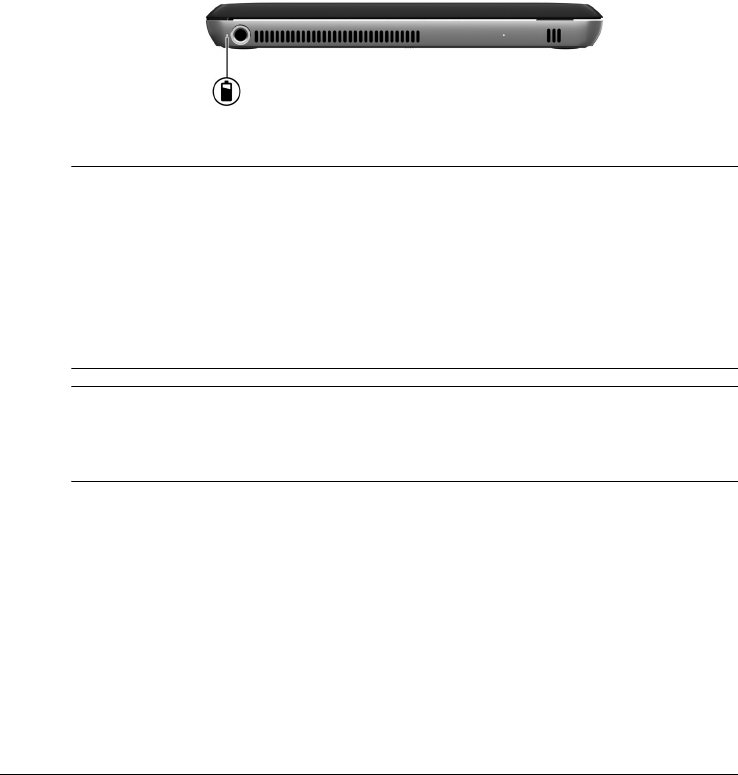
User Manual 1
1 Getting started
To fully charge the battery, leave the computer plugged into external power until the battery
light on the left side of the computer turns white.
ï
WARNING: To reduce the risk of electric shock or damage to your equipment, observe
these guidelines:
■Plug the power cord into an AC outlet that is easily accessible at all times.
■Disconnect power from the computer by unplugging the power cord from the AC
outlet (not by unplugging the power cord from the computer).
■If provided with a 3-pin attachment plug on your power cord, plug the cord into a
grounded (earthed) 3-pin outlet. Do not disable the power cord grounding pin, for
example, by attaching a 2-pin adapter. The grounding pin is an important safety
feature.
✎A partially charged new battery can run the computer after software setup is complete,
but battery charge displays will not be accurate until the new battery has been fully
charged. When the computer is connected to external power, the battery light turns
white when the battery is fully charged.
Charging the battery
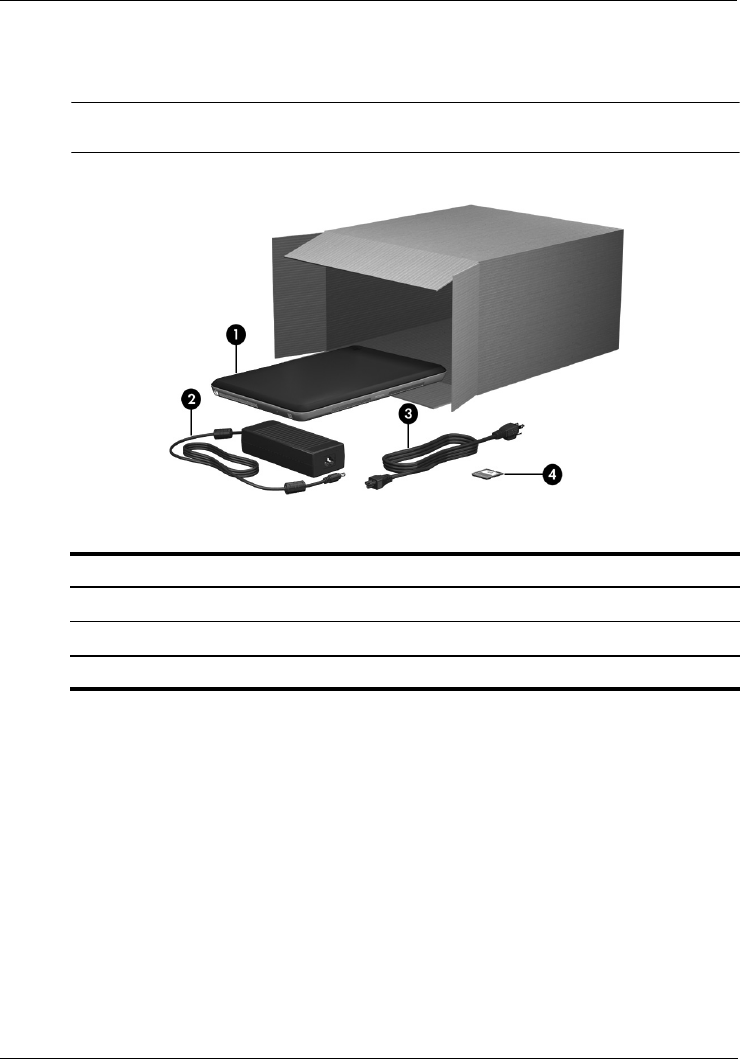
2User Manual
1 Getting started
✎Computer color, features, and options may vary by computer model. The illustrations in
this guide may look slightly different from your computer.
Verifying the box contents
Component Component
1Computer 3Power cord*
2AC adapter 4SD Memory Card
*Power cords vary in appearance by country or region.
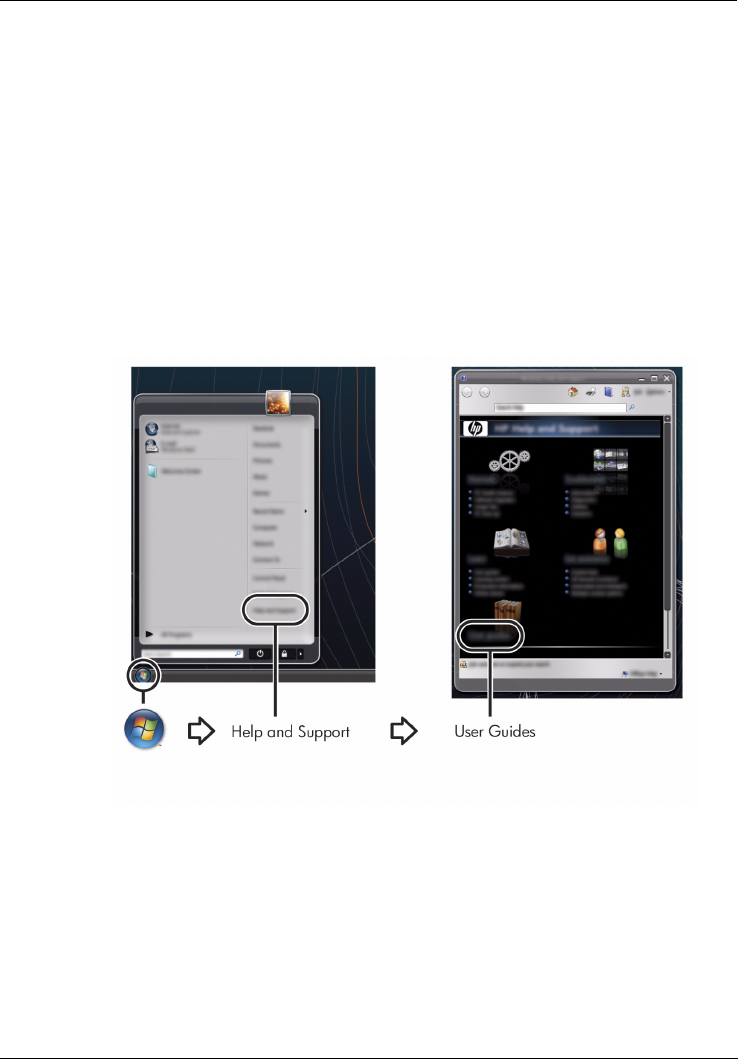
User Manual 3
1 Getting started
User Manual on a Secure Digital (SD) Memory Card
This guide provides information about new features, such as HP QuickWeb software, action
keys, TouchPad gestures, optical drive sharing, as well as details about connecting to the
Internet and multimedia features.
Electronic manuals in Help and Support
For detailed information about your computer, such as information about power
management, multimedia, TouchPad and keyboard, security, and other features, click Start,
click Help and Support, and then click User Guides. You do not need to connect to the
Internet to access the user guides in Help and Support.
Getting information

4User Manual
1 Getting started
Help and Support
In Help and Support, you can find information about technical support, and about the
operating system, drivers, and troubleshooting tools. To access Help and Support, click
Start, and then click Help and Support. For country- or region-specific support, go to
http://www.hp.com/support, select your country or region, and follow the on-screen
instructions.
ï
WARNING: To reduce the risk of serious injury, read the Safety & Comfort Guide. It
describes proper workstation setup, and proper posture, health, and work habits for
computer users. The Safety & Comfort Guide also provides important electrical and
mechanical safety information. To access this document, click Start, click Help and
Support, and then click User Guides. The Safety & Comfort Guide is also available
on the Web at http://www.hp.com/ergo.
Regulatory, safety, and environmental notices
For more safety and regulatory information, and for battery disposal information, refer to the
Regulatory, Safety and Environmental Notices. To access the notices, click Start, click Help
and Support, and then click User Guides.
To turn off the computer from Windows:
1. Save your work and close all programs.
2. Click Start, and then click Shut down.
Turning off the computer from Windows®

User Manual 5
2 What’s new?
Your computer includes the new Windows® 7 operating system. Windows 7 has several new
program and feature enhancements, such as:
■Faster startup
■Updated Wi-Fi network controls
■Customizable taskbar
■Fewer pop-ups and notifications
■Support for more multimedia formats
The Stardock MyColors program (select models only) offers a customizable desktop theme
that transforms the look and feel of your basic Windows desktop. The new desktop includes
custom icons, visual styles (Start button and taskbar), and a corresponding wallpaper.
✎To change back to the standard Windows theme, open the Stardock MyColors program
and select the standard Windows theme.
HP QuickWeb software is an optional, instant-on environment that is separate from your
Windows operating system. QuickWeb allows you to rapidly access certain programs
without the need to start your operating system. You will enjoy this feature if you browse the
Internet, view and send e-mail, view digital photos, listen to music, or keep in touch through
instant messages or Skype. QuickWeb is ready to go within seconds of pressing the power
button.
✎For detailed information on using QuickWeb, refer to Chapter 3, “Using HP QuickWeb
(select models only).”
Windows 7
Customizable desktop
HP QuickWeb software (select models only)
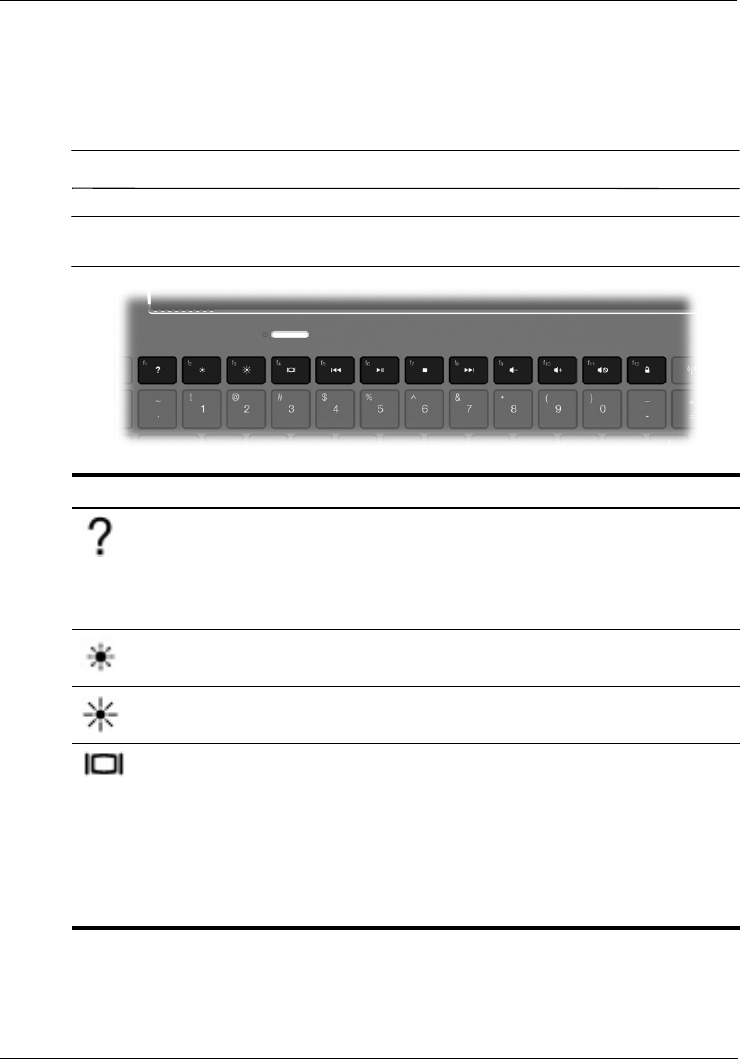
6User Manual
2 What’s new?
Action keys are customized actions that are assigned to specific keys at the top of the
keyboard. To use an action key, press and hold the key to activate the assigned action.
✎Some action keys are not available in QuickWeb.
✎For additional information about action keys, refer to the HP ENVY 15 User Guide. To
access this guide, click Start, click Help and Support, and then click User Guides.
Action keys
Icon Description
Opens Help and Support, which provides information about your Windows
operating system and computer, answers to questions, tutorials, and updates
to your computer.
Help and Support also provides automated troubleshooting and links to
support specialists.
Decreases the screen brightness level incrementally when held down.
Increases the screen brightness level incrementally when held down.
Switches the screen image among display devices connected to the system.
For example, if a monitor is connected to the computer, pressing this key
alternates the screen image from computer display to monitor display to
simultaneous display on both the computer and the monitor.
Most external monitors receive video information from the computer using the
external VGA video standard. The switch screen image key can also alternate
images among other devices that are receiving video information from the
computer.
(Continued)
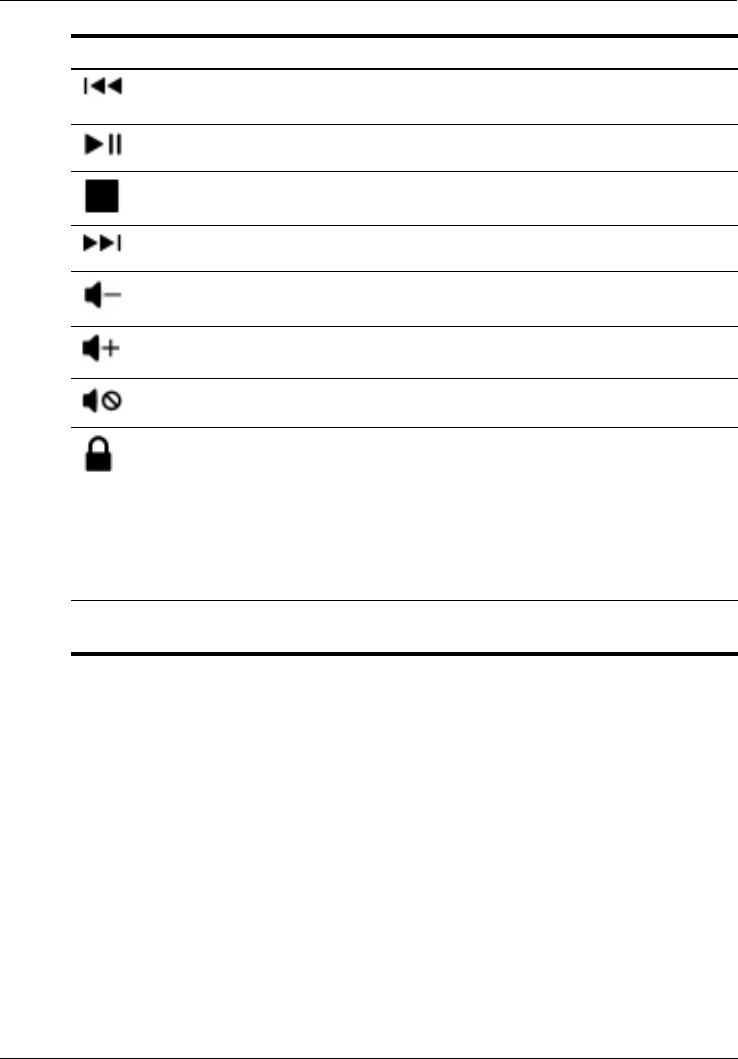
User Manual 7
2 What’s new?
Plays the previous track of an audio CD, or the previous section of a DVD or a
Blu-ray Disc (BD).
Plays, pauses, or resumes an audio CD, a DVD, or a BD.
Stops audio or video playback of a CD, a DVD, or a BD.
Plays the next track of an audio CD or the next section of a DVD or a BD.
Decreases speaker sound incrementally when held down.
Increases speaker sound incrementally when held down.
Mutes or restores speaker sound.
Initiates the QuickLock security feature. QuickLock protects your information
by displaying the operating system Log On window. While the Log On window
is displayed, the computer cannot be accessed until a Windows user password
or a Windows administrator password is entered.
✎Before you can use QuickLock, you must set a Windows user password
or a Windows administrator password. For instructions, refer to Help
and Support.
prt sc Takes a snapshot or picture of your computer screen and copies it to the
clipboard.
Icon Description
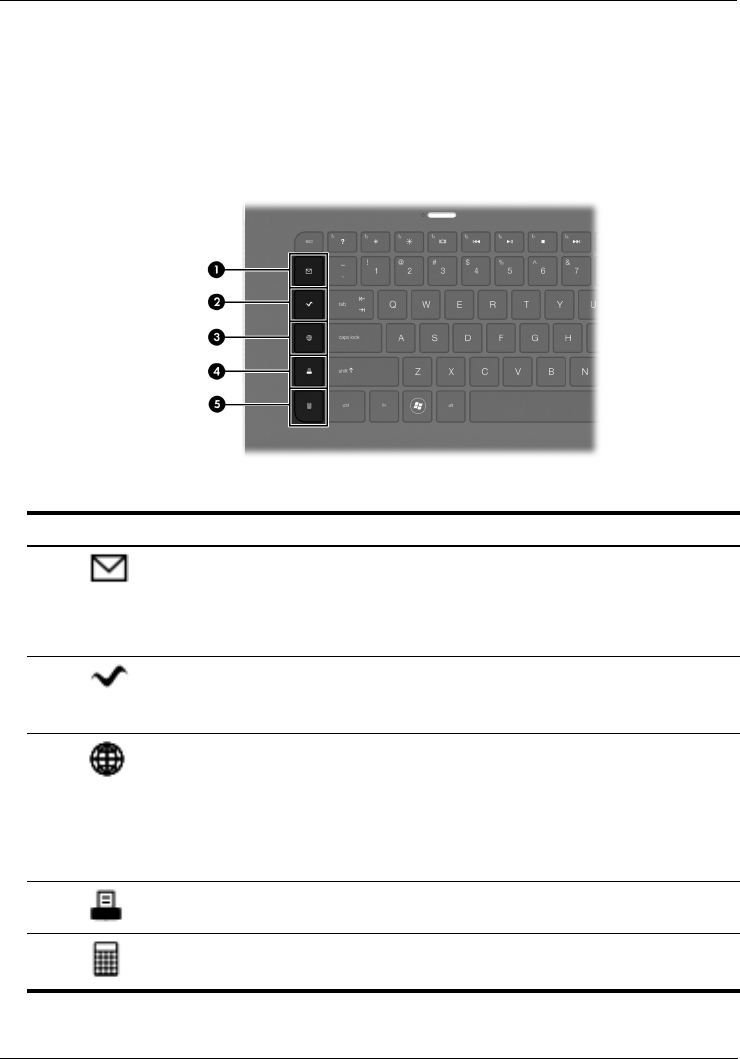
8User Manual
2 What’s new?
One-touch launch keys are customized actions that are assigned to specific keys on the left
side of the keyboard.
To use a one-touch launch key, press the key to activate the assigned action.
One-touch launch keys
Item Icon Description
1Opens your default e-mail program.
✎The first time you press the mail key, you may be prompted to set up
your e-mail account. After you have set up your e-mail account, you
can press the mail key to quickly access your e-mail.
2Opens HP MediaSmart. HP MediaSmart turns your computer into a mobile
entertainment center. You can enjoy music and movies, and manage and edit
your photo collections.
3Opens a Web browser.
✎Until you have set up your Internet or network services, the Web key
opens the Windows Internet Connection Wizard. After you have set up
your Internet or network services and your Web browser home page,
you can press the Web key to quickly access your home page and the
Internet.
4Opens the Print Options window of the active Windows program.
5Opens the Windows calculator function.
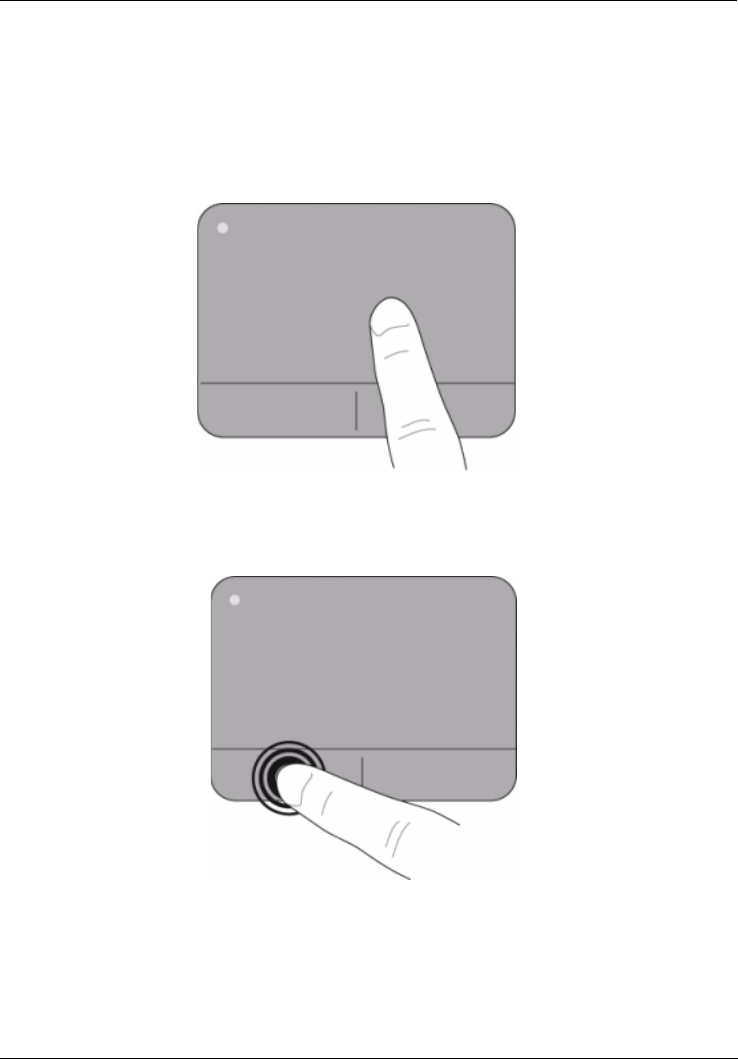
User Manual 9
2 What’s new?
Navigating
To move the pointer, slide one finger across the TouchPad in the direction you want the
pointer to go.
Selecting
Use the left and right TouchPad buttons like the corresponding buttons on an external mouse.
TouchPad
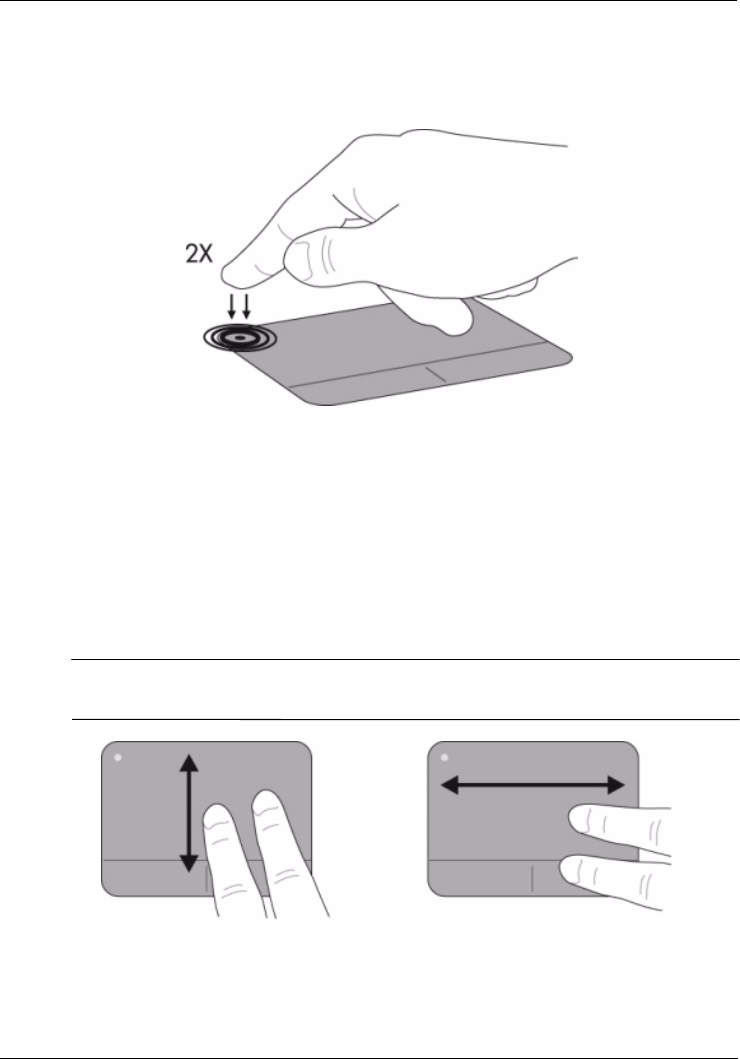
10 User Manual
2 What’s new?
Turning the TouchPad on and off
To turn the TouchPad on and off, quickly double-tap the TouchPad off indicator. When the
TouchPad is on, the light is off.
Using TouchPad gestures
The TouchPad supports gestures that make it easy and fun to work with images or pages of
text. To activate the TouchPad gestures, place 2 fingers on the TouchPad at the same time as
described in the following sections.
Scrolling
Scrolling is useful for moving up or down on a page or image. To scroll, place two fingers
slightly apart on the TouchPad and drag them across the TouchPad in an up, down, left, or
right motion.
✎Scrolling speed is controlled by finger speed.
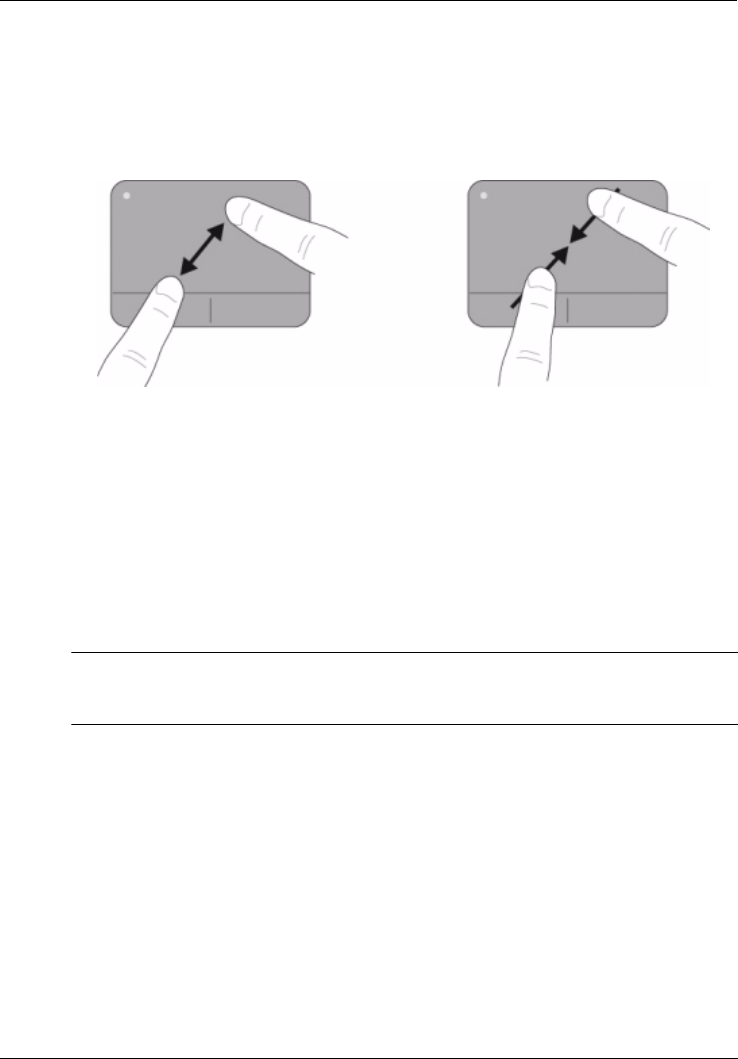
User Manual 11
2 What’s new?
Pinching/Zooming
Pinching allows you to zoom in or out on items such as PDFs, images, and photos.
■Zoom in by placing two fingers together on the TouchPad, and then moving them apart.
■Zoom out by placing two fingers apart on the TouchPad, and then moving them
together.
Setting preferences
Scrolling and pinching are enabled at the factory. You computer also supports additional
TouchPad gestures that are disabled at the factory.
To disable or reenable TouchPad gestures or to explore other TouchPad gestures:
1. Double-click the Synaptics icon in the notification area, at the far right of the taskbar,
and then click the Device Settings tab.
2. Select the device, and then click Settings.
3. Select the check box to disable or reenable the TouchPad gesture.
4. Click Apply, and then click OK.
✎For additional information about using the TouchPad, refer to the HP ENVY 15 User
Guide. To access this guide, click Start, click Help and Support, and then click User
Guides.
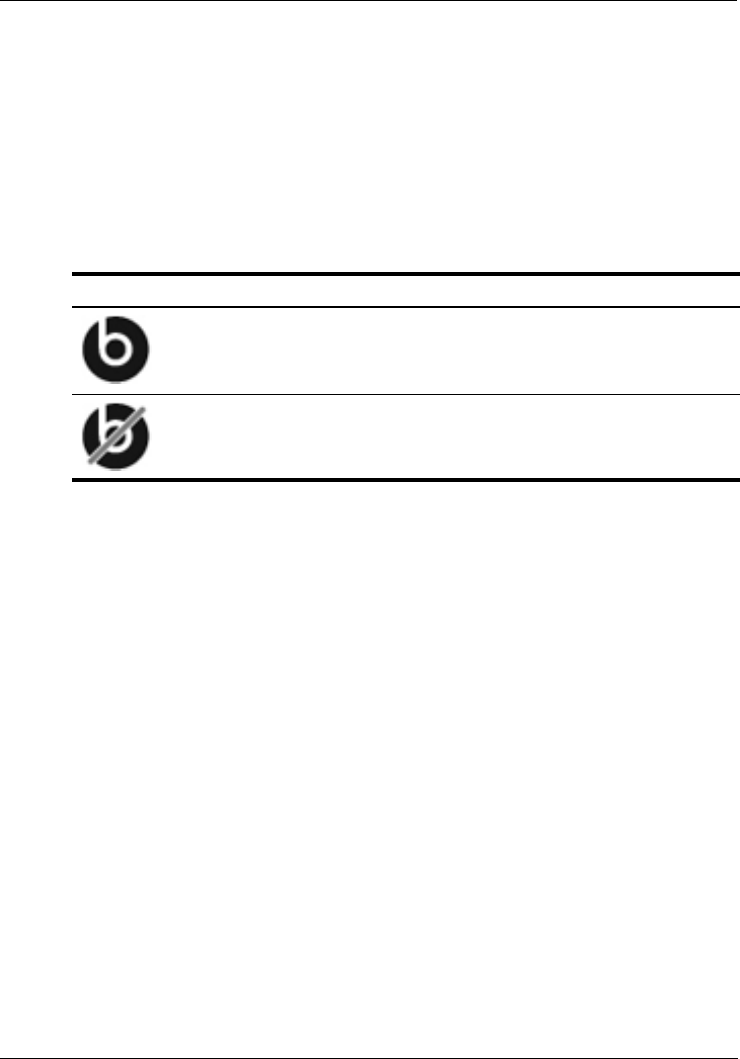
12 User Manual
2 What’s new?
Beats Audio is an enhanced audio profile that provides a deep, controlled bass while
maintaining a clear sound. Beats Audio is enabled by default.
»To increase or decrease the Beats Audio bass settings, press fn+b.
You can also view and control the bass settings through the Windows operating system. Click
Start, click Control Panel, click Sound, and then click Speakers and Headphone
Properties to view and control the bass properties.
The following table shows and describes the Beats Audio icons.
Beats Audio
Icon Description
Indicates that Beats Audio is connected.
Indicates that Beats Audio is not connected.

User Manual 13
2 What’s new?
Although your computer does not have an integrated optical drive, you can easily access
software, install programs, and access information by sharing an optical drive connected to
another computer in your network. Drive sharing is a feature of the Windows operating
system that allows a drive on one computer to be accessible to other computers on the same
network.
✎You must have a network set up in order to share an optical drive. Refer to Help and
Support for information on setting up a network.
✎Some discs, such as DVD movies and game discs, may be copy-protected and therefore
unusable through DVD or CD sharing.
To share an optical drive:
1. From the computer with the optical drive you want to share, click Start, and then click
Computer.
2. Right-click the optical drive you want to share, and then click Properties.
3. Click the Sharing tab, and then click Advanced Sharing.
4. Select the Share this folder check box.
5. Type a name for the optical drive in Share name text box.
6. Click Apply, and then click OK.
7. To view the shared optical drive on your computer, click Start, click Control Panel,
click Network and Internet, and then click Network and Sharing Center.
Sharing optical drives

User Manual 15
3 Using HP QuickWeb (select models only)
HP QuickWeb is an optional, instant-on environment that is separate from your Windows
operating system. QuickWeb allows you to rapidly access a Web browser, and other
communication and multimedia programs, without the need to start Windows. QuickWeb is
ready to go within seconds of pressing the power button after system setup. QuickWeb
includes the following features:
■Web browser—Search and browse the Internet, and create links to your favorite
Web sites.
■Chat—Chat with friends on multiple instant messaging programs, such as Google Talk,
Windows Live Messenger, Yahoo! Messenger, and other providers.
■Skype (select models only)—Skype is a voice over Internet protocol (VoIP) that lets you
communicate free of charge with other Skype users. With Skype, you can have a
conference call or a video chat with one or more people at a time. You can also make
long-distance phone calls to land lines.
■Web e-mail—View and send e-mail using Yahoo, Gmail, and other Web e-mail
providers.
■Web calendar—Display, edit, and organize your schedule using your favorite online
calendar program.
■Music Player—Listen to your favorite music and create playlists.
■Photo Viewer—Browse through photos, create albums, and view slide shows.
Is QuickWeb for Nikita 1.2 the same as Nikita 1.1?

16 User Manual
3 Using HP QuickWeb (select models only)
The first time you turn on your computer after completing the Windows setup process, the
QuickWeb setup screens appear. Follow the on-screen instructions to activate QuickWeb. At
the end of the setup process, you are given the choice to start Windows or to continue to
QuickWeb for the current session. If you select the option to start QuickWeb, the QuickWeb
Home screen appears. Click an icon on the QuickWeb Home screen to launch a program.
✎The QuickWeb Home screen may look slightly different from the illustration in this
section.
✎The following section assumes that you have completed the QuickWeb setup process
and enabled QuickWeb. For more information, refer to the QuickWeb software Help.
QuickWeb allows you to access a Web browser, and other communication and multimedia
programs, within seconds without starting Windows. To start QuickWeb when the computer
is powered off:
1. Turn on your computer. The HP QuickWeb Home screen appears.
2. Click an icon on the QuickWeb Home screen to launch a program.
Setting up HP QuickWeb for the first time

User Manual 17
3 Using HP QuickWeb (select models only)
✎If QuickWeb has been activated, it will start every time you power up your computer.
To start Microsoft Windows, you must click the Windows Start icon in the QuickWeb
Home screen.
To start Microsoft Windows:
1. Turn on your computer. The HP QuickWeb Home screen appears.
2. Click the Windows Start icon on the far left of the QuickWeb Home screen.
3. A dialog box appears, asking if you are sure you want to start Windows. Click Yes.
✎Clicking on the Make Windows your default Power On experience in this dialog box
disables QuickWeb. To reenable QuickWeb, refer to the section “Disabling and
enabling HP QuickWeb,” later in this chapter.
The following table shows and describes the QuickWeb control buttons.
Starting Microsoft® Windows®
Identifying the QuickWeb control buttons
Icon Description
Launches the Windows operating system.
Turns off the computer from QuickWeb.
For details on turning off the computer from Windows, refer to “Turning off the
computer from Windows®” in Chapter 1.
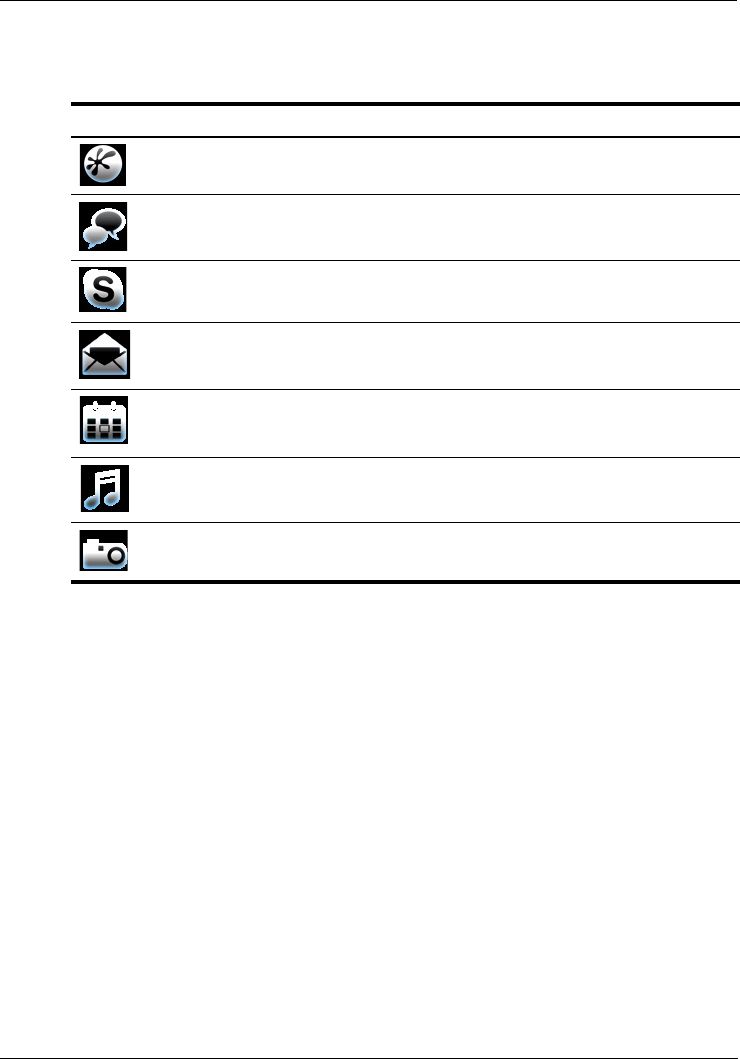
18 User Manual
3 Using HP QuickWeb (select models only)
Identifying the LaunchBar icons
The following table shows and describes HP QuickWeb icons.
Icon Description
Launches the Web browser. You can bookmark your favorite Web sites and
view Web pages.
Launches the Chat application. This is compatible with Google Talk, Windows
Live Messenger, Yahoo! Messenger, and other providers.
Launches Skype (select models only). This is a voice over Internet protocol
(VoIP) that lets you communicate free of charge with other Skype users.
Launches Web e-mail so you can view your Web-based e-mail programs, such
as Gmail, Hotmail, Yahoo, and other Web e-mail providers.
Launches Web calendar so you can schedule and manage your activities using
your favorite online calendar application.
Launches Music Player. Select and play music stored on your hard drive or
external drives. Supports .mp3 files.
Launches Photo Viewer. Browse photos stored on your hard drive or external
drive. Supports .bmp, .gif, .jpg, and .png file types.
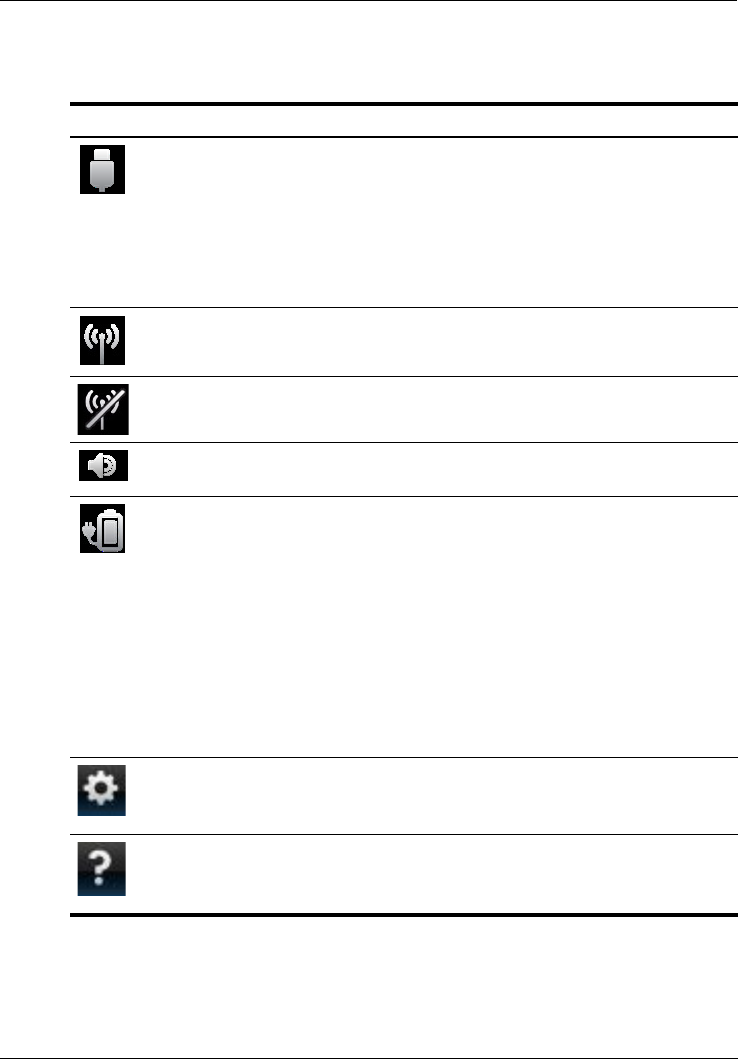
User Manual 19
3 Using HP QuickWeb (select models only)
Identifying the notification icons
The following table shows and describes the notification icons:
Icon Description
Indicates that a USB drive is present. If a USB drive is inserted, the File
Manager window containing a USB icon appears. Click the USB icon to open
the File Manager window. Right-click the USB icon to open a menu to safely
eject the device.
✎If your HP ENVY 15 comes equipped with USB 3.0, please note that
only the eSATA/USB 2.0 port may be used for USB devices while in HP
QuickWeb mode.
Indicates that the network is connected. Click the Network icon to open the
Network dialog box.
Indicates that the network is disconnected.
Controls volume for speakers and the microphone. Click the Volume Control
icon to open the Volume Control dialog box.
Controls power settings:
■When the computer is connected to AC power, the icon appears with an
AC power cord.
■When the computer is running on battery power, the icon appears as only a
battery.
The state of charge is indicated by the color of the Battery icon:
■Green: charged
■Yellow: low
■Red: critical low
Click the Battery icon to display a menu to control power settings and to see
information about battery capacity.
Launches the Settings panel. Use the Settings panel to modify QuickWeb
settings such as date and time. Refer to the following section, “Using the
Settings panel” for more information.
Displays the QuickWeb software Help.

20 User Manual
3 Using HP QuickWeb (select models only)
1. After turning on the computer, click the Settings icon.
The Settings panel selection box is displayed.
2. Click the icon that corresponds to the system setting you want to modify. Choose from
any of the following:
❏Date and Time
❏Input Language
❏Language and Keyboard
❏Network
❏Environment Settings
❏Screen Settings
❏Volume Control
❏Applications
✎For more information on changing settings in the Settings panel, refer to the HP
QuickWeb software Help.
QuickWeb can be configured to set up a wireless connection by using the HP QuickWeb
Configuration Tool. To access this tool, click the Settings icon, click Network, and then
select the Enable Wi-Fi check box. For more information on setting up a wireless connection
using HP QuickWeb and Windows, refer to Chapter 4, “Connecting to the Internet,” and to
the HP QuickWeb software Help.
To play music:
1. Click the Music icon on the LaunchBar.
Music Player is displayed.
2. On the left side of the Music Player window, navigate to the directory that contains your
music files. The directory can be on either your hard drive or an external drive.
3. Click a music file you want to play from the list on the right side of the window.
4. When you are finished making your music selection, click the Play icon at the bottom
right of the window.
Using the Settings panel
Configuring the network
Playing music

User Manual 21
3 Using HP QuickWeb (select models only)
To view photos:
1. Click the Photos icon on the LaunchBar.
Photo Viewer is displayed.
2. On the left side of the Photo Viewer window, navigate to the directory that contains your
photos. The directory can be on either your hard drive or an external drive. The right
side of the Photo Viewer window displays thumbnail views of all the photos in the
selected directory.
3. Double-click the thumbnail of the photo you want to view.
The photo thumbnail views appear at the bottom right of the Photo Viewer window. A
larger view of the selected photo appears above the thumbnails.
4. Navigate the thumbnail views by pressing the right arrow key or left arrow key, or by
clicking the next thumbnail image you want to see enlarged.
Chat is an instant messaging program that is compatible with Google Talk, Yahoo!
Messenger, and other providers.
To start an instant messaging session:
1. Click the Chat icon on the LaunchBar. The buddy list window and a configuration tool
are displayed.
2. In the buddy list window, click Help to get information on configuring Chat for your
instant messaging protocol and setting up your account. You can also configure Chat to
work with an existing instant messaging account.
Skype is a voice over Internet protocol (VoIP) that lets you communicate free of charge with
other Skype users. You can also make long-distance phone calls to land lines at lower costs
than many long-distance carriers charge.
To start Skype:
1. Click the Skype icon on the LaunchBar.
A Sign in to Skype window is displayed.
2. Click the Create a new Skype Account tab.
3. Before you proceed, read the information provided by the links at the bottom of the
Create Account window, to be sure that you understand the terms and possible charges
you can incur from using Skype.
✎For more information on using Skype, refer to the software Help.
Browsing photos
Creating instant messages with Chat
Making Internet phone calls with Skype (select models only)

22 User Manual
3 Using HP QuickWeb (select models only)
You can disable or reenable QuickWeb in two ways.
To disable or reenable QuickWeb from within the Windows operating system:
1. Click Start, click All Programs, and then click HP QuickWeb. The HP QuickWeb
Installer folder displays. Click HP QuickWeb Configuration Tool.
2. Select the Enable QuickWeb check box.
3. Click OK.
✎The HP QuickWeb Configuration Tool can also be accessed by clicking Start, clicking
Control Panel, and then clicking the View by arrow. Select Large icons or Small icons
to locate the HP QuickWeb Configuration Tool.
To disable or reenable QuickWeb from within Setup Utility:
1. Open Setup Utility by turning on or restarting the computer. Immediately press f10
repeatedly to start Setup Utility.
2. Use the right arrow key to tab across the menu headings and select System
Configuration.
3. Use the down arrow key to select Boot Options, and then press enter. The Boot Options
screen opens.
4. Use the down arrow key to select HP QuickWeb, and then press enter.
5. Use the arrow keys to select Disable or Enable, and then press enter.
6. To save your change and exit Setup Utility, use the arrow keys to select Exit, select Exit
Saving Changes, and then press enter.
Disabling and enabling HP QuickWeb

User Manual 23
4 Connecting to the Internet
✎Internet hardware and software features vary depending on the computer model and
your location.
The computer supports 2 types of Internet access:
■Wired—You can access the Internet by connecting to a broadband network using the
RJ-45 (network) jack. To learn how to connect to a wired network, refer to the
“Connecting to a wired network” section.
■Wireless—For mobile Internet access, you can use a wireless connection. To learn
about adding the computer to an existing network or setting up a wireless network, refer
to the “Connecting to an existing wireless network” section or the “Setting up a new
wireless network” section.
The networking features of the computer enable you to access high-speed broadband Internet
service providers with the following types of connections:
■Cable modem
■Digital Subscriber Line (DSL)
■Satellite
■Other services
Broadband access may require additional hardware or software provided by your Internet
service provider (ISP).
The following features will help you set up a new Internet account or configure the computer
to use an existing account:
■Choosing an ISP: You must set up Internet service before you can connect to the
Internet. Contact a local ISP to purchase Internet service and a modem. The ISP will
help set up the modem, install a network cable to connect your wireless computer to the
modem, and test the Internet service.
✎Your ISP will give you a user ID and password to access the Internet. Record this
information and store it in a safe place.
■Internet Services & Offers (available in some locations): This utility assists with
signing up for a new Internet account and configuring the computer to use an existing
account. To access this utility, click Start, click All Programs, click Online Services,
and then click Get Online.
Choosing the type of Internet access
Using an ISP
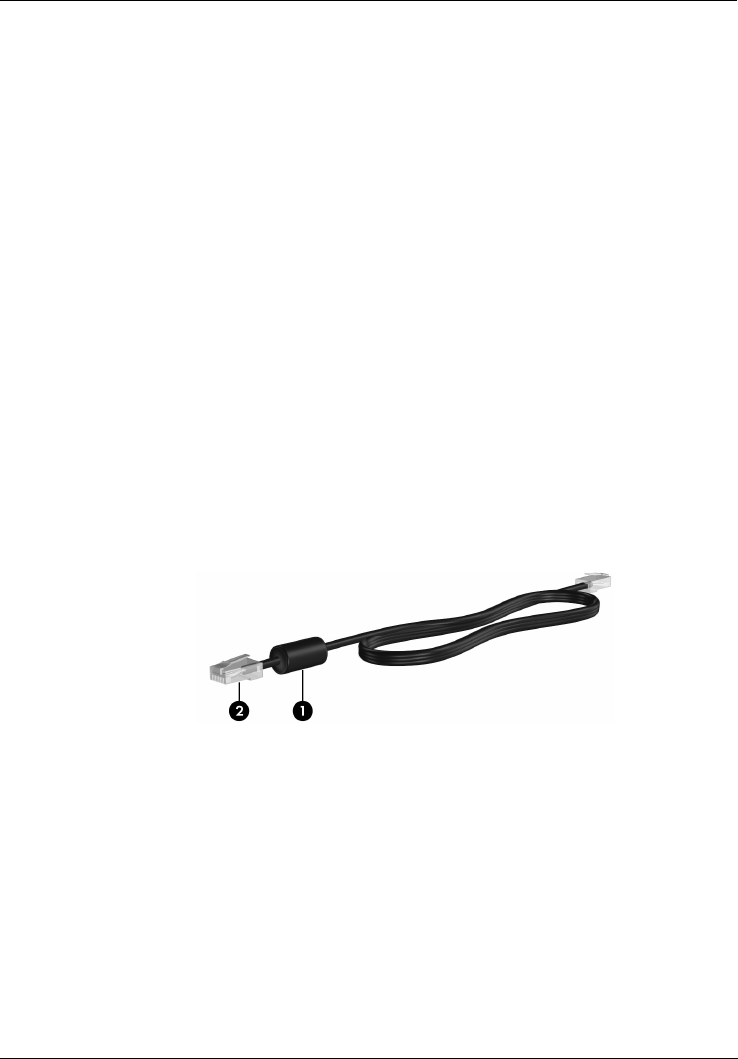
24 User Manual
4 Connecting to the Internet
■ISP-provided icons (available in some locations): These icons may be displayed either
individually on the Windows desktop or grouped in a desktop folder named Online
Services. To set up a new Internet account or configure the computer to use an existing
account, double-click an icon, and then follow the on-screen instructions.
■Windows Connect to the Internet Wizard: You can use the Windows Connect to the
Internet Wizard to connect to the Internet in any of these situations:
❏You already have an account with an ISP.
❏You have a disc from an ISP.
❏You do not have an Internet account and want to select an ISP from the list provided
within the wizard. (The list of ISP providers is not available in all regions.)
❏You have selected an unlisted ISP, and the ISP has provided you with information
such as a specific IP address and POP3 and SMTP settings.
To access the Windows Connect to the Internet Wizard and instructions for using it,
click Start, click Help and Support, and then type Connect to the Internet wizard in the
Search box.
Connecting to a wired network requires a network cable (purchased separately). If the cable
contains noise suppression circuitry 1, which prevents interference from TV and radio
reception, orient the circuitry end of the cable 2 toward the computer.
Connecting to a wired network
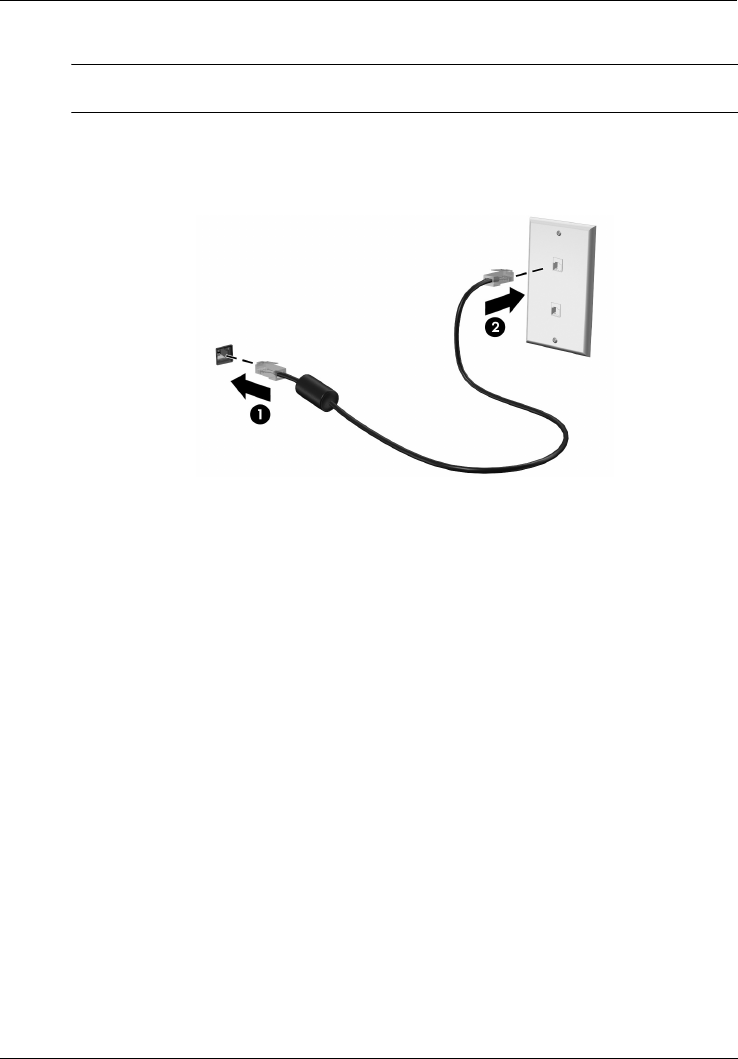
User Manual 25
4 Connecting to the Internet
To connect the cable:
ï
WARNING: To reduce the risk of electric shock, fire, or damage to the equipment,
do not plug a modem or telephone cable into the RJ-45 (network) jack.
1. Connect the network cable to the RJ-45 (network) jack 1 on the computer.
2. Connect the other end of the network cable to a network wall jack 2.
To connect the computer to an existing wireless network, follow these steps:
1. Click the network icon in the notification area, at the far right of the taskbar.
2. Select the network to which you want to connect.
3. Click Connect.
4. If required, enter the security key.
Connecting to an existing wireless network
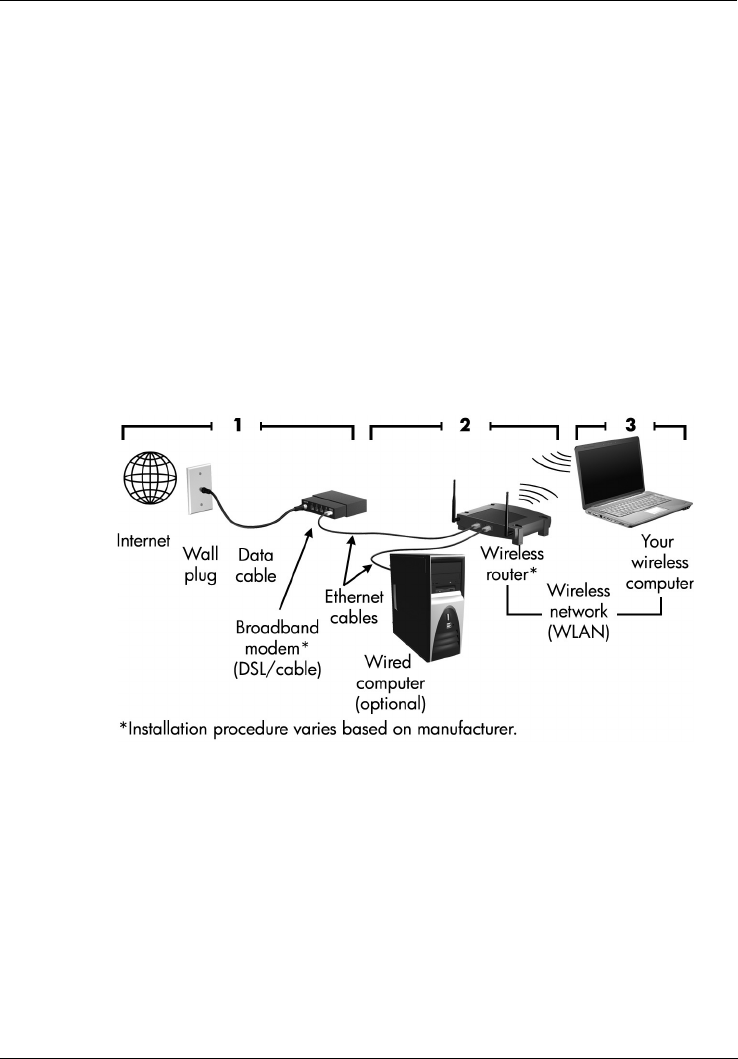
26 User Manual
4 Connecting to the Internet
This section describes how to use a wireless computer to set up a typical home or small office
wireless network, which is also called a wireless local area network (WLAN).
To set up a wireless network and to connect to the Internet, you need the following
equipment:
■A broadband modem (either DSL or cable) and high-speed Internet service purchased
from an Internet service provider (ISP)
■A wireless router (purchased separately)
■Your new wireless computer
The following illustration shows an example of a completed wireless network installation
that is connected to the Internet and to a wired computer. As this network grows, additional
wireless and wired computers can be connected to the network to access the Internet.
Setting up a new wireless network

User Manual 27
4 Connecting to the Internet
Step 1: Purchase and install a wireless router
Read this section carefully before you install the wireless router using the router
manufacturer's instructions and your wireless computer. If you need technical assistance
during the router installation, contact the router manufacturer.
✎Temporarily connect your new wireless computer to the router by using the network
cable provided with the router. This will ensure that the computer can access the
Internet.
1. Be sure that the wireless device is off (the wireless light on the computer is amber). If
the wireless device is on, press the wireless key to turn it off. For help locating the
wireless key or light, refer to the HP ENVY 15 User Guide in Help and Support.
2. During the router installation, the router manufacturer's software allows you to change
the network name (SSID) and enable security to protect the privacy of your wireless
network. Many routers are shipped with a default network name and with security
disabled. If you change the default network name or enable security during the router
setup, record the information and store it in a safe place. You will need this information
when you configure the computer and any other existing computers to access the router.
✎If you do not enable security, an unauthorized wireless user can access the
information on the computer and use your Internet connection without your
knowledge. For more information on securing your wireless network, refer to the
HP ENVY 15 User Guide in Help and Support.
The Windows operating system also provides tools to help you set up your wireless network
for the first time. To use the Windows tools to set up your network, click Start, click Control
Panel, click Network and Internet, click Set up a new connection or network, and then
click Set up a new network. Follow the on-screen instructions.
Step 2: Configure the computer to connect to the wireless network
1. If the computer is off, turn it on.
2. Be sure that the wireless device is on (the wireless light is off). For help locating the
wireless key or light, refer to the HP ENVY 15 User Guide in Help and Support.
3. Connect the computer to the wireless network:
a. Click the network icon in the notification area, at the far right of the taskbar.
b. Select the network to which you want to connect.
c. Click Connect.
d. If required, enter the security key.
4. Test the wireless network by opening your Web browser and accessing a Web site.

User Manual 29
5 Multimedia features
The following section highlights the entertainment features of the computer.
The computer includes preinstalled multimedia software.
»To see a list of the software that is preinstalled on the computer, click Start, and then
click All Programs.
✎For details about using software included with the computer, refer to the software
manufacturer’s instructions, which may be provided with the software, on disc, or on
the manufacturer’s Web site.
If you have an external optical drive (purchased separately), you can also perform the
following multimedia tasks:
■Playing digital media, including audio and video CDs, audio and video DVDs, and BDs
■Listening to Internet radio
■Creating (burning) data CDs
■Burning and editing audio CDs
■Burning and editing video DVDs or video CDs
✎The external optical drive must be connected to the USB port on the
computer, not to a USB port on another external device, such as a hub or
docking station.
Installing multimedia software from a disc
Although your computer does not have an integrated optical drive, you can easily access
software as well as install programs and access information in either of the following ways:
■Connect an external optical drive (purchased separately) to one of the USB ports on
your computer.
■Share an optical drive that is connected to another computer on your network.
✎Refer to the “Sharing optical drives” section in Chapter 2 for additional
information.
Using multimedia software

30 User Manual
5 Multimedia features
MediaSmart turns your computer into a mobile entertainment center. With MediaSmart,
you can enjoy music and movies, and also manage and edit photo collections.
»To start MediaSmart, click Start, click All Programs, click HP, and then click
HP MediaSmart.
MediaSmart includes the following features:
■Internet TV—View a range of TV shows and channels, as well as the HP-TV channel
streamed in full-screen mode to computers with an Internet connection.
■Photo and video upload support, for example:
❏Upload your MediaSmart photos to Internet photo storage sites, such as Snapfish.
❏Upload your home videos (for example, fun videos created with the integrated
webcam) directly to YouTube.
■Pandora Internet radio (North America only)—Listen to music selected just for you,
streamed from the Internet.
Your computer includes an integrated webcam, located at the top of the display. With the
preinstalled software, you can use the webcam to take a photo or record a video. You can then
preview the photo or video recording, and save it on your computer hard drive. The webcam
is a perfect companion to your instant messaging program.
»To access the webcam, click Start, click All Programs, click HP, click
HP MediaSmart, and then click HP MediaSmart Webcam.
The webcam software enables you to experiment with the following features:
■Capturing and sharing video
■Streaming video with instant messaging software
■Taking still photos
Using HP MediaSmart
Using the webcam

User Manual 31
5 Multimedia features
Your computer enables you to use a variety of audio features:
■Playing music using your computer speakers and/or connected external speakers.
■Controlling the bass with the Beats Audio feature (fn+b).
■Recording sound using the internal microphone, or connect an external microphone.
■Downloading music from the Internet.
■Creating multimedia presentations using audio and images.
■Transmitting sound and images with instant messaging programs.
■Streaming radio programs.
■Creating (burning) audio CDs with an optional optical drive.
Your computer enables you to use a variety of video features:
■Watch movies
■Play games over the Internet
■Edit pictures and video and create presentations
■Connect external video devices
■Watch TV over the Internet
Connecting an external monitor or projector
You can connect an external display such as a monitor or projector to the computer, using the
HP HDMI to VGA Display Adapter (select models only). The adapter connects to the HDMI
port on the computer.
Connecting an HDMI device
The computer includes an HDMI (High Definition Multimedia Interface) port. The HDMI
port connects the computer to an optional video or audio device, such as a high-definition
television, or any compatible digital or audio component.
✎For more information on multimedia features, refer to the HP ENVY 15 User Guide. To
access this guide, click Start, click Help and Support, and then click User Guides.
Using audio features
Using video features

User Manual 33
6 Updating software
Most software, including the operating system, is updated frequently by the manufacturer
or provider. Important updates to the software included with the computer may have been
released since the computer left the factory.
Some updates may affect the way the computer responds to optional software or external
devices. Many updates provide security enhancements.
Update the operating system and other software installed on the computer as soon as the
computer is connected to the Internet. To access links for updating installed software, refer
to Help and Support.
Updated versions of the software provided with your computer may be available on the
HP Web site.
Most software updates on the HP Web site are packaged in compressed files called SoftPaqs.
Some download packages contain a file named Readme.txt, which contains information on
installing and troubleshooting the file.
✎For information on updating the BIOS, refer to the HP ENVY 15 User Guide. To access
this guide, click Start, click Help and Support, and then click User Guides.
To download and install software other than a BIOS update, follow these steps:
1. Open your Web browser, go to http://www.hp.com/support, and select your country or
region.
2. Click the option for software and driver downloads, type your computer model number
in the Search box, and then press enter.
– or –
If you want a specific SoftPaq, enter the SoftPaq number in the Search box, press enter,
and then follow the instructions provided. Proceed to step 6.
3. Click your specific product from the models listed.
4. Select your operating system.
5. When the list of drivers is displayed, click an updated driver to open a window
containing additional information.
Updating the software installed on the computer
Updating programs and drivers

34 User Manual
6 Updating software
6. Click Install now to install the updated driver without downloading the file.
– or –
Click Download only to save the file to your computer. When prompted, click Save,
and then select a storage location on your hard drive.
After the file is downloaded, navigate to the folder where the file was stored, and
double-click the file to install the driver.
7. If you are prompted to do so, restart your computer after the installation is complete, and
then verify the operation of the device.

User Manual 35
7 Backup and recovery
Tools provided by the operating system and by HP Recovery Manager software are designed
to help you with the following tasks for safeguarding your information and restoring it in
case of a system failure:
■Backing up your information
■Creating a set of recovery discs
■Creating system restore points
■Recovering a program or driver
■Performing a full system recovery
HP recommends that you create recovery discs to be sure that you can restore your system to
its original factory state if you experience serious system failure or instability. Create these
discs after setting up the computer for the first time.
✎If your computer does not include an integrated optical drive, you can use an optional
external optical drive (purchased separately) to create recovery discs, or you can
purchase recovery discs for your computer from the HP Web site. The external optical
drive must be connected to the USB port on the computer, not to a USB port on another
external device, such as a hub or docking station.
Handle these discs carefully and keep them in a safe place. The software allows the creation
of only one set of recovery discs.
Note the following guidelines before creating recovery discs:
■You will need high-quality DVD-R, DVD+R, BD-R (writable Blu-ray) or CD-R discs.
All these discs are purchased separately. DVDs have a larger storage capacity than CDs.
If you use CDs, up to 20 discs may be required, whereas only a few DVDs are required.
✎Double-layer discs and read-write discs—such as CD-RW, DVD±RW, and
BD-RE (rewritable Blu-ray) discs—are not compatible with the Recovery
Manager software.
■The computer must be connected to AC power during this process.
■Only one set of recovery discs can be created per computer.
■Number each disc before inserting it into an optical drive.
■If necessary, you can exit the program before you have finished creating the recovery
discs. The next time you open Recovery Manager, you will be prompted to continue the
disc creation process.
To create a set of recovery discs:
1. Click Start, click All Programs, click Recovery Manager, and then click Recovery
Disc Creation.
2. Follow the on-screen instructions.
Creating recovery discs

36 User Manual
7 Backup and recovery
As you add new software and data files, you should back up your system on a regular basis to
maintain a reasonably current backup. Back up your system at the following times:
■At regularly scheduled times
✎Set reminders to back up your information periodically.
■Before the computer is repaired or restored
■Before you add or modify hardware or software
Note the following when backing up:
■Create system restore points using the Windows System Restore feature, and
periodically copy them to a disc.
■Store personal files in the Documents library, and periodically back up this folder.
■Back up templates stored in their associated programs.
■Save the customized settings in a window, toolbar, or menu bar by taking a screen shot
of the settings. The screen shot can be a time-saver if you have to reset your preferences.
To copy the screen and paste the image into a word-processing document:
a. Display the screen.
b. Copy the screen:
◆To copy only the active window, press alt+prt sc.
◆To copy the entire screen, press prt sc.
c. Open a word-processing document, click Edit, and then click Paste.
d. Save the document.
■You can back up your information to an optional external hard drive, a network drive, or
discs.
■When backing up to discs, use any of the following types of discs (purchased
separately): CD-R, CD-RW, DVD+R, DVD-R, or DVD±RW. The discs you use depend
on the type of optical drive you are using.
✎DVDs store more information than CDs, so using them for backup reduces the
number of recovery discs required.
■When backing up to discs, number each disc before inserting it into an optical drive.
Backing up your information

User Manual 37
7 Backup and recovery
To create a backup using Windows Backup and Restore, follow these steps:
✎Be sure that the computer is connected to AC power before you start the backup
process.
✎The backup process may take over an hour, depending on file size and the speed of the
computer.
1. Click Start, click All Programs, click Maintenance, and then click Backup and
Restore.
2. Follow the on-screen instructions to set up and create a backup.
✎Windows® includes the User Account Control feature to improve the security of
your computer. You may be prompted for your permission or password for tasks
such as installing software, running utilities, or changing Windows settings. Refer
to Help and Support for more information.
When you back up your system, you are creating a system restore point. A system restore
point allows you to save and name a snapshot of your hard drive at a specific point in time.
You can then revert back to that point if you want to reverse subsequent changes made to
your system.
✎Recovering to an earlier restore point does not affect data files saved or e-mails created
since the last restore point.
You also can create additional restore points to provide increased protection for your system
files and settings.
When to create restore points
■Before you add or extensively modify software or hardware.
■Periodically, whenever the system is performing optimally.
✎If you revert to a restore point and then change your mind, you can reverse the
restoration.
Using Windows Backup and Restore
Using system restore points

38 User Manual
7 Backup and recovery
Creating a system restore point
1. Click Start, click Control Panel, click System and Security, and then click System.
2. In the left pane, click System protection.
3. Click the System Protection tab.
4. Under Protection Settings, select the disk for which you want to create a restore point.
5. Click Create.
6. Follow the on-screen instructions.
Restoring to a previous date and time
To revert to a restore point (created at a previous date and time) when the computer was
functioning optimally, follow these steps:
1. Click Start, click Control Panel, click System and Security, and then click System.
2. In the left pane, click System protection.
3. Click the System Protection tab.
4. Click System Restore.
5. Follow the on-screen instructions.
✎You can recover only files that you have previously backed up. HP recommends that
you use Recovery Manager to create a set of recovery discs (entire drive backup) as
soon as you set up your computer.
Recovery Manager software allows you to repair or restore the system if you experience
system failure or instability. Recovery Manager works from recovery discs that you create or
from a dedicated recovery partition (select models only) on the hard drive. However,
computers that include a solid-state drive (SSD) may not have a recovery partition. If that is
the case, recovery discs have been included with your computer. Use these discs to recover
your operating system and software.
✎Windows has its own built-in repair features, such as System Restore. If you have not
already tried these features, try them before using Recovery Manager. For more
information on these built-in repair features, click Start, and then click Help and
Support.
✎Recovery Manager recovers only the software that was preinstalled at the factory.
Software not provided with this computer must be downloaded from the manufacturer’s
Web site or reinstalled from the disc provided by the manufacturer.
Performing a recovery

User Manual 39
7 Backup and recovery
Recovering using the recovery discs
To restore the system from the recovery discs:
1. Back up all personal files.
2. Insert the first recovery disc into an optional external optical drive, and restart the
computer.
3. Follow the on-screen instructions.
Recovering using the partition on the hard drive (select models only)
On some models, you can perform a recovery from the partition on the hard drive, which is
accessed by pressing either the Start button or f11. This restores the computer to its factory
condition.
✎Computers with an SSD may not have a recovery partition. If the computer does not
have a recovery partition, you will not be able to recover using this procedure. Recovery
discs have been included for computers that do not have a partition. Use these discs to
recover your operating system and software.
To restore the system from the partition, follow these steps:
1. Access Recovery Manager in either of the following ways:
Click Start, click All Programs, click Recovery Manager, and then click Recovery
Manager.
– or –
a. Turn on or restart the computer, and then press esc while the “Press the esc key for
Startup Menu” message is displayed at the bottom of the screen.
b. Press f11 while the “Press <F11> for recovery” message is displayed on the screen.
✎It may take several minutes for Recovery Manager to load.
2. In the Recovery Manager window, click System Recovery.
3. Follow the on-screen instructions.

User Manual 41
A Product information and troubleshooting
The power information in this section may be helpful if you plan to travel internationally
with the computer.
The computer operates on DC power, which can be supplied by an AC or a DC power source.
Although the computer can be powered from a standalone DC power source, it should be
powered only with an AC adapter or a DC power source supplied and approved by HP for use
with this computer.
The computer can operate on DC power within the following specifications.
✎This product is designed for IT power systems in Norway with phase-to-phase voltage
not exceeding 240 V rms.
✎The computer operating voltage and current can be found on the system regulatory label
on the bottom of the computer.
Input power
Input power Rating
Operating voltage 19.5 V dc @ 6.50 A - 120W
Operating current 6.50 A
Operating environment
Factor Metric U.S.
Temperature
Operating (writing to optical disc) 5°C to 35°C 41°F to 95°F
Nonoperating -20°C to 60°C -4°F to 140°F
Relative humidity (noncondensing)
Operating 10% to 90% 10% to 90%
Nonoperating 5% to 95% 5% to 95%
Maximum altitude (unpressurized)
Operating -15 m to 3,048 m -50 ft to 10,000 ft
Nonoperating -15 m to 12,192 m -50 ft to 40,000 ft

42 User Manual
A Product information and troubleshooting
For best results, follow these traveling and shipping tips:
■Prepare the computer for traveling or shipping:
1. Back up your information.
2. Remove all discs and all external media cards, such as digital cards.
ï
To reduce the risk of damage to the computer, damage to a drive, or loss of
information, remove the media from a drive before removing the drive from a
drive bay, and before shipping, storing, or traveling with a drive.
3. Turn off and then disconnect all external devices.
4. Shut down the computer.
■Take along a backup of your information. Keep the backup separate from the computer.
■When traveling by air, carry the computer as hand luggage, and do not check it in with
the rest of your bags.
ï
Avoid exposing a drive to magnetic fields. Security devices with magnetic fields
include airport walk-through devices and security wands. The airport security
devices that check carry-on luggage, such as conveyor belts, use X-rays instead
of magnetism and will not damage a drive.
■In-flight computer use is at the discretion of the airline. If you plan to use the computer
during a flight, check with the airline in advance.
■If the computer will be unused and disconnected from external power for more than
2 weeks, remove the battery and store it separately.
■If you are shipping the computer or a drive, use suitable protective packaging and label
the package “FRAGILE.”
■If the computer has a wireless device or a cell phone device installed, such as an
802.11b/g device, a Global System for Mobile Communications (GSM) device, or a
General Packet Radio Service (GPRS) device, the use of these devices may be restricted
in some environments. Such restrictions may apply onboard aircraft, in hospitals, near
explosives, and in hazardous locations. If you are uncertain of the policy that applies to
the use of a particular device, ask for authorization to use it before you turn it on.
■If you are traveling internationally, follow these suggestions:
❏Check the computer-related customs regulations for each country or region on your
itinerary.
❏Check the power cord and adapter requirements for each location in which you plan
to use the computer. Voltage, frequency, and plug configurations vary.
ï
To reduce the risk of electric shock, fire, or damage to the equipment, do not
attempt to power the computer with a voltage converter kit sold for appliances.
Traveling with the computer

User Manual 43
A Product information and troubleshooting
Cleaning the display
ï
CAUTION: To prevent permanent damage to the computer, never spray water,
cleaning fluids, or chemicals on the display.
To remove smudges and lint, frequently clean the display with a soft, damp, lint-free cloth.
If the screen requires additional cleaning, use premoistened antistatic wipes or an antistatic
screen cleaner.
Cleaning the TouchPad and keyboard
Dirt and grease on the TouchPad can cause the pointer to jump around on the screen. To
avoid this, clean the TouchPad with a damp cloth, and wash your hands frequently when
using the computer.
ï
WARNING: To reduce the risk of electric shock or damage to internal components,
do not use a vacuum cleaner attachment to clean the keyboard. A vacuum cleaner
can deposit household debris on the keyboard surface.
Clean the keyboard regularly to prevent keys from sticking, and to remove dust, lint, and
particles that can become trapped beneath the keys. A can of compressed air with a straw
extension can be used to blow air around and under the keys to loosen and remove debris.
If you experience computer problems, perform these troubleshooting steps in the sequence
provided until the problem is resolved:
1. Refer to “Quick troubleshooting,” the next section in this chapter.
2. Access Web site links and additional information about the computer through Help and
Support. Click Start, and then click Help and Support.
✎Although many checkup and repair tools require an Internet connection, other
tools, such as Help and Support, can help you fix a problem when the
computer is offline.
Routine care
Troubleshooting resources

44 User Manual
A Product information and troubleshooting
The computer is unable to start up
If the computer does not turn on when you press the power button, the following suggestions
may help you resolve the problem:
■If the computer is plugged into an AC outlet, unplug the computer, and then plug
another electrical device into the outlet to be sure that the outlet is providing adequate
power.
✎Use only the AC adapter provided with the computer or one approved by HP
for this computer.
■If the computer is running on battery power, or if it is plugged into an external power
source other than an AC outlet, plug the computer into an AC outlet using the AC
adapter. Be sure that the power cord and AC adapter connections are secure.
The TouchPad is behaving erratically
If the TouchPad is behaving erratically, follow these guidelines:
■Be sure that TouchPad is on. If the TouchPad light is amber, quickly double-tap the
TouchPad on/off button to turn on the TouchPad. If the TouchPad light is off, the
TouchPad is on.
■Follow these guidelines when using the TouchPad:
❏Use one finger to navigate, click, or turn on/turn off the TouchPad.
❏Use 2 fingers to control TouchPad gestures, such as scrolling, pinching/zooming,
and rotating.
✎To turn the TouchPad gestures off or explore other TouchPad features, click the
Synaptics icon in the notification area at the far right of the taskbar, click the Device
Settings tab, and then click Settings.
The computer screen is blank
If the screen is blank, but the computer is on and the power light is on, the computer may not
be set to display the image on the computer screen. To transfer the image to the computer
screen, press the switch screen image key.
Software is functioning abnormally
If the software is unresponsive or responds abnormally, follow these suggestions:
■Restart the computer by clicking Start, clicking the arrow next to Shut down, and then
clicking Restart.
If you cannot restart the computer using this procedure, refer to the next section, “The
computer is on but is not responding.”
■Run a virus scan. For information about using the antivirus resources on the computer,
refer to the antivirus software Help for more details.
Quick troubleshooting

User Manual 45
A Product information and troubleshooting
The computer is on but is not responding
If the computer is on but is not responding to software or keyboard commands, try the
following emergency shutdown procedures, in the sequence provided, until shutdown occurs:
ï
CAUTION: Emergency shutdown procedures will result in the loss of unsaved
information.
■Press and hold the power button on the computer for at least 5 seconds.
■Disconnect the computer from external power and remove the battery.
The computer is unusually warm
It is normal for the computer to feel warm to the touch while it is in use. But if the computer
feels unusually warm, it may be overheating because a vent is blocked.
If you suspect that the computer is overheating, turn off the computer to allow the computer
to cool to room temperature. Then be sure to keep all vents free from obstructions while you
are using the computer.
ï
WARNING: To reduce the possibility of heat-related injuries or of overheating the
computer, do not place the computer directly on your lap or obstruct the computer
air vents. Use the computer only on a hard, flat surface. Do not allow another hard
surface, such as an adjoining optional printer, or a soft surface, such as pillows or
rugs or clothing, to block airflow. Also, do not allow the AC adapter to contact the
skin or a soft surface, such as pillows or rugs or clothing, during operation. The
computer and the AC adapter comply with the user-accessible surface temperature
limits defined by the International Standard for Safety of Information Technology
Equipment (IEC 60950).
✎The fan in the computer starts up automatically to cool internal components and prevent
overheating. It is normal for the internal fan to cycle on and off during routine
operation.
An external device is not working
Follow these suggestions if an external device does not function as expected:
■Turn on the device according to the manufacturer’s instructions.
■Be sure that all device connections are secure.
■Be sure that the device is receiving electrical power.
■Be sure that the device, especially if it is older, is compatible with the operating system.
■Be sure that the correct drivers are installed and updated.

46 User Manual
A Product information and troubleshooting
The wireless network connection is not working
If a wireless network connection is not working as expected, follow these suggestions:
■Click Start, click Control Panel, click Network and Internet, and then click Network
and Sharing.
■Be sure that the wireless device is turned on (wireless light is off). If the light is amber,
press the wireless key to turn on the wireless device.
■Be sure that the computer wireless antennas are free from obstructions.
■Be sure that the cable or DSL modem and its power cord are properly connected and
that the lights are on.
■Be sure that the wireless router or access point is properly connected to its power
adapter and the cable or DSL modem, and that the lights are on.
■Turn the wireless device off and then on again to resynchronize the device.
■Disconnect and then reconnect all cables, and turn the power off and then back on.
✎For more information on wireless technology, refer to the relevant Help topics and Web
site links in Help and Support.
✎For information on activating mobile broadband service, refer to the mobile network
operator information included with your computer.

User Manual 47
Index
A
action keys, identifying 6
altitude specifications 41
audio features 31
B
backing up 36
Beats Audio 12, 31
C
cable, modem 23
cables and cords, power 44
calculator key 8
Chat 21
connecting to a wired network 24
connecting to an existing wireless network
25
D
devices, external, troubleshooting 45
drivers, updating 33
E
environmental specifications 41
external devices, troubleshooting 45
external monitor 31
H
HDMI device 31
Help and Support key 6
HP HDMI to VGA Display Adapter 31
HP MediaSmart 30
humidity specifications 41
I
Internet
choosing an ISP 23
choosing type of access 23
wireless access 23
Internet service provider (ISP) 23
L
LaunchBar icons, identifying 18
M
mail key 8
media keys 7
Media Launch key 8
Microsoft Windows
default power on 17
starting 17
monitor, external 45
multimedia software 29
Music Player 15
N
notification icons, identifying 19
O
one-touch launch keys, identifying 8
operating environment specifications 41
optical drive, sharing 13
overheating, computer 45
P
partition 39
Photo Viewer 15
pinching gesture 11
power, turning on the computer 44
print options key 8
printer 45
programs, updating 33
Q
QuickLock key 7
QuickWeb
browsing photos 21
configuring the network 20
disabling or enabling 22
features 15
identifying 17
playing music 20
setting up 16
Settings Panel 20
QuickWeb software, using 5

Index
48 User Manual
R
recovery discs, creating 35
Recovery Manager 38, 39
recovery, performing 38
recovery, system 35
regulatory information notices 4
Regulatory, Safety and
Environmental Notices 4
S
screen brightness keys 6
scrolling gesture 10
Skype 21
software
multimedia 29
safeguarding information 35
updating 33
specifications
altitude 41
humidity 41
operating environment 41
temperature 41
switch screen image key 6
system recovery 35
system restore points 37
T
temperature
specifications 41
troubleshooting 45
TouchPad gestures 9
troubleshooting 43
external device problems 45
overheating problems 45
resources 43
software problems 44
virus problems 44
wireless network problems 46
turning on the computer 44
V
vents, precautions 45
video features 31
volume keys 7
W
Web browser 15
Web browser key 8
Web calendar 15
Web e-mail 15
webcam 30
Windows Backup and Restore 37
wireless Internet access 23
wireless network connection 25
Z
zooming gesture 11